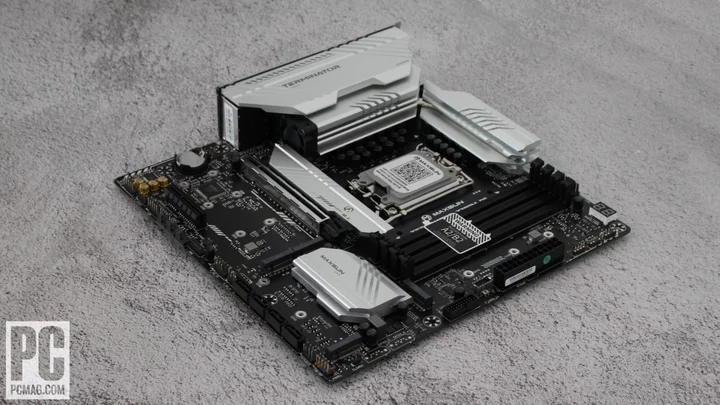Maxsun isn't a familiar brand to many in the U.S., but enthusiasts in Eastern markets know its AMD-, Nvidia-, and Intel-based products ranging from motherboards and graphics cards to solid-state drives and memory modules. Here, we're checking out the company's Terminator Z790M D5 Wi-Fi, an Intel LGA 1700 motherboard that per Maxsun's naming convention uses the MicroATX ("M") form factor and supports DDR5 ("D5"). The board has the most M.2 storage sockets you'll find in MicroATX—a total of five—plus four SATA ports, integrated Wi-Fi 6E and 2.5Gbps Ethernet, a budget audio codec, and dual (front and rear) USB 3.2 Gen 2x2 (20Gbps) Type-C ports. With a current MSRP of $249.99, it's a relatively expensive option among MicroATX Z790 motherboards. But if "all the M.2 storage you can mount in the least space" is your thing, it's worth it.
Design, CPU, and Memory
The Terminator Z790M D5 Wi-Fi sits on a multi-layer black PCB with black slots and sockets and silver accents for the voltage regulator module (VRM), M.2, and chipset heatsinks. The stark contrast is neutral bordering on bland, especially since it lacks integrated RGB elements, but it should fit in with most build themes. Unique to a board at this price point, the VRMs are actively cooled, which is helpful as the configuration isn't particularly robust.
The limit of four SATA ports and two PCI Express expansion slots could be a turnoff for users who have heavy investments in SATA-based storage or plan to install a number of cards, and I would have liked to see a state-of-the-art PCIe 5.0 M.2 socket. Still, while the design won't exactly jump out of your chassis, it has everything you need for a well-rounded PC.
The Terminator supports Intel's 12th and 13th Gen LGA 1700 processors, including the flagship Core i9-13900K and Core i9-13900KS. The eight 50A Metal Oxide Semiconductor Field-Effect Transistors, or MOSFETs, dedicated to the processor are a bit anemic, but still managed to handle our CPU without an issue during testing. The actively cooled heatsinks kept the power bits beneath running well within specification, even with overclocking, but they do tend to get hot with sustained multi-threaded loads. If you're pushing a high-end processor, be sure your chassis also has effective airflow as this board lets the CPU run at the higher 253-watt (W) power limit without jumping back to 125W.
(Credit: Joe Shields)Memory support is listed up to DDR5-7000+ (OC), which is on the low end for the Z790 platform but well past the sweet spot as far as price and performance. Much past DDR5-6000 to -6400, you're spending big bucks for tiny performance gains. If you need a lot of RAM, the board's limit of 192GB is plenty for even the most hardcore home users.
(Credit: Joe Shields)Our DDR5-5600 and DDR5-6000 kits were perfectly stable by setting the internal XMP profile. You should be clear to run higher-speed memory if you stick to the QVL list for assured support.
Layout and Internal Connectors
Starting in the top left corner, we spy 8-pin (required) and 4-pin EPS connectors to power the processor. On each side are two large VRM heatsinks connected via a 6mm heat pipe to cool the power components hiding below. As mentioned, you'll find a small fan on the VRMs to help the heatsinks. The fan was inaudible over ambient noise, which is more than we can say for other boards with active cooling. With the board advertising full 253W support for high-end processors, every little bit helps. The left VRM heatsink features Terminator branding, while you can find the Maxsun name on the chipset heatsink.
Continuing to the right, we run into four RAM slots with the locking mechanism at top. Above them are the first two of six 4-pin fan/pump headers. All these headers support PWM- and DC-controlled devices. The website and manual don't appear to list their output, so it's safest to assume 1A/12W each, as overloading these headers could permanently damage your motherboard. Control over these headers is handled through the BIOS.
At upper right is a two-character debug LED to help troubleshoot POST issues. If you experience a problem during the POST process, the LED displays a value corresponding to where the trouble is.
(Credit: Joe Shields)Moving down the right edge of the motherboard, we find all three RGB headers—two 3-pin ARGB and one 4-pin RGB. Control over these devices is handled through the BIOS or the MaxsunLED app which you can download from the website. Below is the 24-pin ATX connector to power the board, a front-panel USB 3.2 Gen 2x2 (20Gbps) Type-C port, and a 19-pin front-panel USB 3.2 Gen 1 (5Gbps) header. You'll also see one of the five M.2 sockets, squeezed vertically into this space. MicroATX motherboards have only so much real estate!
Audio, Expansion, Storage, and Rear I/O
In the bottom left corner is a fully exposed audio section, including the Realtek ALC897 codec and four yellow capacitors dedicated to audio. Sadly, you won't find the audio separation line to reduce EMI (electromagnetic interference) that's common on other boards. The ALC897 is a budget codec, but many users will still find it perfectly acceptable.
In the middle of the board are two PCI Express expansion slots and the remaining four M.2 sockets. The top PCIe slot uses reinforcement to protect against shearing and EMI, connects through the CPU, and supports up to PCIe 5.0 x16 speeds. The bottom slot, an open-ended x4 connector that sources bandwidth through the chipset, peaks at PCIe 3.0 x4 speeds. While you'll find only two slots, you should have enough bandwidth to add more devices via PCIe expansion.
(Credit: Joe Shields)Four of the five M.2 sockets are mixed in and around the PCIe slots. All five M.2 sockets run up to PCIe 4.0 x4 modes and support only PCI Express modules. (SATA-bus M.2 devices won't work in these M.2 slots.) The manual doesn't mention any lane sharing or conflicts, so in theory, you should be able to run all these concurrently. Most of the sockets fit up to 80mm modules except for M.2_2/3, which allows larger drives up to 110mm. Be aware that only the top socket (M.2_1) comes with a heatsink. If you have any hot-running drives, you'll want to add your own heatsinks to prevent thermal throttling (especially on PCIe 4.0 x4 drives).
Along the bottom edge of the board are several headers, including an additional USB 2.0 header, three 4-pin fan headers, COM and TPM ports, front-panel audio, and front-panel headers. Finally, you'll find the four vertically mounted SATA ports. If you want to gain redundancy or speed through storage, these ports support RAID 0, 1, 5, and 10 modes.
(Credit: Joe Shields)The rear I/O of this Maxsun board features a preinstalled I/O plate with gray labels on a white background. The nine USB ports here should be enough for most users. You'll find a fast USB 3.2 Gen 2x2 (20Gbps) Type-C port, four USB 3.2 Gen 1 (5Gbps) Type-A ports, and five vintage USB 2.0 (480Mbps) ports. HDMI and DisplayPort connectors for integrated video output sit next to a convenient clear-CMOS button to reset the BIOS. On the networking side are 2.5GbE Realtek and Intel Wi-Fi 6E antenna connections. Last is the audio stack containing five analog plugs and the SPDIF out. Nothing is out of the ordinary here, but nothing is missing, either.
A Brief Look at the UEFI BIOS and Utilities
The Maxsun BIOS is useful and has all the options you need, though it won't win any awards. To begin with, it lacks the Easy (or EZ) Mode of other motherboard makers; everything is "advanced mode" with headings listed across the top. The BIOS comes with a black background with a portal or door image; its white text and yellow headers make it easy to read. You'll find plenty of options to tweak, as many as you'll find from the "big four" board partners; it just omits their refined looks and Easy Mode.
(Credit: Maxsun)The Main section is mostly informative, displaying BIOS, processor, and RAM data along with current system details, including CPU and VRM temps, fan speeds, voltages, and more.
(Credit: Maxsun)The Advanced section is the place to configure your hardware. From the CPU to the network, graphics, and USB, you'll find it here. Not pictured is the Power section that deals with hibernation and how the system responds to power-off and power-on situations.
(Credit: Maxsun)A Turbo section presents all your options for tweaking the performance of the processor and RAM. Here you can set XMP modes for RAM and manually tweak speeds and timings. For the processor, plenty of options are available, including voltage and frequency adjustments, offsets, and more.
Ultimately, the Maxsun BIOS works fine but lacks the maturity of other BIOSes, at least in terms of appearance. The primary board partners present users more refined UEFIs. But this shouldn't be a deal-breaker as you'll find all the functionality needed to tweak this board to the limit.
Maxsun doesn't provide much in the way of utilities. All I could find on the website was the MaxsunLED app to control compatible RGB LEDs attached to the integrated headers. Otherwise, extra software is nonexistent.
(Credit: Maxsun)The MaxsunLED app I found available for download is mostly not written in English: I was able to make out up to eight LED modes and speed and brightness adjustments via sliders, but it was otherwise unreadable for me. You can input a custom color in hexadecimal or RGB.
Verdict: A Solid Shot at Competing With the Big Boards
Maxsun's Terminator Z790M D5 Wi-Fi gives users another valid small-form-factor option in the Intel Z790 space—the only option for those looking to leverage a lot of M.2 storage. Its black-and-white appearance blends in with most build themes but doesn't provide any integrated RGB lighting. Performance was a plus, as the board, surprisingly, bypasses Intel specs and runs up the turbo limit to 253W for our Core i9-13900K without dropping down. Essentially, you're only limited by your CPU cooling.
(Credit: Joe Shields)As far as competitors go, MSI's entries in the MicroATX arena are in B760 form (such as the $179.99 MAG B760M Mortar Wi-Fi). Asus sells the Prime Z690M-Plus Wi-Fi for $205.99 and Gigabyte the Z790M Aorus Elite AX for about $50 more. All are valid choices, but the Maxsun's ample M.2 storage is its greatest selling point. Its appearance is unexciting and it would be more appealing with a price cut, but the Terminator Z790M D5 Wi-Fi fills a useful MicroATX niche.









